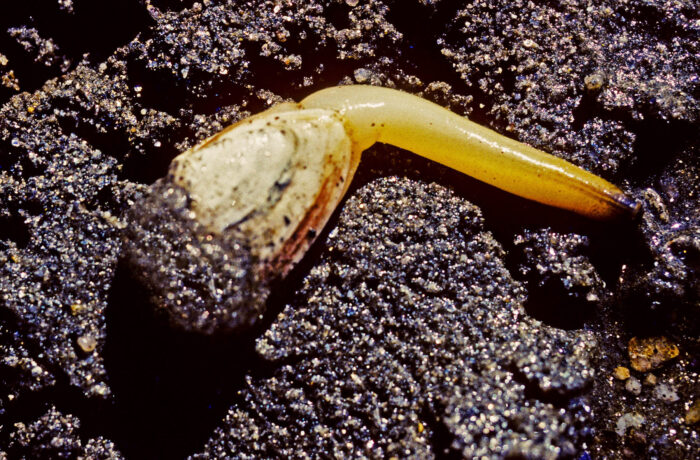Soft Shell Clam
Mya arenaria
The soft shell clam is a bivalve with thin, elongated shells. It lives buried in soft sediments in the middle Chesapeake Bay.
This section shows one large critter image at a time. Use the thumbnails that follow to select a specific image to display here.

This gallery contains a grid of small thumbnails. Selecting a thumbnail will change the main image in the preceding section.
Appearance
The soft shell clam's thin, oval shells grow to 3 to 4 inches in length. Its shells are white with a thin, brittle covering that varies in color from brownish to gray. One foot and two long, leathery siphons protrude from either end. The left shell has a spoon-like depression at the hinge, which the right shell fits into.
Feeding
As filter feeders, soft shell clams draw in water through one siphon, then filter out plankton from the water. Unused water and particles are ejected through the other siphon.
Predators
Adult soft shell clams have many natural predators, including raccoons, blue crabs, horseshoe crabs, diving ducks and cownose rays.
Reproduction and life cycle
These clams usually spawn twice per year: once in late spring and once in mid- to late autumn. Both eggs and sperm are released into the water column. The number of eggs a female releases depends on its size. Eggs develop into larvae within one day of being fertilized.
Larvae swim freely for about 1-3 weeks, during which they develop a foot and shells. Larvae eventually find a suitable place to settle and anchor themselves to the bottom using thin threads secreted from a gland on the foot. Juvenile soft shell clams can be very active. Eventually they find a permanent place to burrow. Some soft shell clams have been known to live 12 years.
Did you know?
- Adults can only move vertically and cannot rebury themselves if removed from their burrow.
- Historically, hundreds of thousands of bushels of soft shell clams were harvested in the Chesapeake Bay. For the last 30 years, the number of bushels harvested in Maryland has declined due to many factors including disease and decreased catch limits. Now, only hundreds of bushels are recorded.
- Unlike most other clams, soft shell clams cannot completely retract their siphons into their shells.
- When disturbed, soft shell clams squirt water out of their siphon.
Sources and additional information
- Life in the Chesapeake Bay by Alice Jane Lippson and Robert L. Lippson
- Chesapeake Bay: Nature of the Estuary, A Field Guide by Christopher P. White
- Chesapeake & Coastal Bay Life: Soft Shell Clam – Maryland Department of Natural Resources
